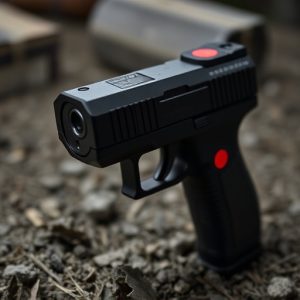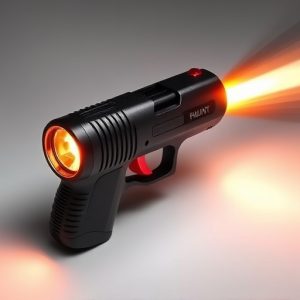Mastering the Runt Stun Gun: A Safe and Legal Training Guide
The RUNT stun gun is a compact yet powerful self-defense device that serves as an alternative to tr…….
The RUNT stun gun is a compact yet powerful self-defense device that serves as an alternative to traditional weapons for personal protection. Proper training is essential for its safe and effective use, involving understanding the device's components, functional aspects, and safety protocols. Users must familiarize themselves with the user manual, practice in secure environments with protective gear, and regularly inspect the stun gun for damage. Training should include a variety of scenarios to prepare for real-life encounters, focusing on proper grips, aiming, and target acquisition across different distances and angles. Legal compliance is non-negotiable; users must adhere to state and local laws that govern the possession and use of stun guns, as they are classified as dangerous weapons. Training programs must be overseen by qualified instructors who ensure all activities are conducted within legal frameworks, thereby maintaining public trust and safety. Proficiency with the RUNT stun gun, coupled with other defensive skills and a comprehensive understanding of its legal application, is crucial for effective self-defense strategies.
When it comes to personal safety devices, the Runt stun gun stands out as a compact yet effective tool for self-defense. This article delves into the essentials of Runt stun gun training, ensuring you grasp its capabilities and safety measures. From understanding the device’s mechanics to mastering training techniques that enhance its use, we cover all aspects. Additionally, we navigate the legal landscape surrounding stun gun ownership to keep you informed and compliant. Embark on a safer path with expert insights on Runt stun gun training.
Understanding the Runt Stun Gun: A Comprehensive Overview
The runt stun gun is a self-defense tool that has gained attention for its compact size and effectiveness in deterring threats. Unlike its larger counterparts, the runt stun gun is designed for concealability and ease of use. Its diminutive stature belies the power it packs; a mere grasp can deliver a high-voltage electric shock to an assailant, effectively neutralizing a threat without the need for lethal force. Training with this device is crucial for understanding its operational mechanics, including how to deploy it swiftly and accurately under stress. Users must familiarize themselves with the stun gun’s features, such as the location of the charge release button, the orientation of the prongs for maximum impact, and the maintenance required to ensure consistent performance. Safety protocols are also an integral part of training, as improper use can lead to unintended consequences. Incorporating the runt stun gun into a comprehensive self-defense regimen involves not only mastering its handling but also integrating it with other defensive techniques for a well-rounded approach to personal safety. Prospective users should seek out specialized training courses that cover both the technical and situational aspects of using the runt stun gun effectively, ensuring they are prepared to protect themselves should the need arise.
Safety Precautions When Handling and Training with a Runt Stun Gun
When integrating a runt stun gun into your self-defense training regimen, prioritizing safety is paramount. Proper handling of this device involves understanding its mechanisms and limitations. Firstly, ensure that you are well-versed in the user manual provided by the manufacturer. This documentation outlines the safe operating procedures and guidelines specific to the runt stun gun model you possess. Familiarization with these instructions reduces the risk of accidental discharge or misuse.
Safety precautions extend beyond reading the manual; they also encompass the environment in which training takes place. Choose a safe, controlled space free from obstacles that could cause injury upon shock deployment. Additionally, when practicing with a partner, make certain that both parties are attuned to the device’s effects and are equipped with the necessary protective gear. This includes rubber soled shoes to prevent electric shocks from conducting through the floor, as well as eye protection to safeguard against accidental muscle contractions around the eyes. Regularly inspect the runt stun gun for any signs of wear or damage that could impair its functioning or safety. Adhering to these precautions ensures a safer training experience, fostering competence and confidence in handling your runt stun gun effectively.
Effective Training Techniques for Maximizing the Use of Your Runt Stun Gun
When integrating a RUNT stun gun into your personal safety arsenal, it’s crucial to engage in comprehensive training to ensure its effective use when needed. The RUNT stun gun, designed for its compact and concealable form, offers a non-lethal means of self-defense that can be a deterrent against potential attackers. To maximize the utility of this device, it’s essential to understand its features, limitations, and proper handling techniques.
Training should begin with familiarizing yourself with the stun gun’s components, functions, and safety features. Practice activating the unit in a safe environment to become comfortable with its operation. Next, focus on developing confidence in your grip and aim. Dry fire exercises, where you simulate pulling the trigger without actual electroshock deployment, can help reinforce proper technique. Once proficient, progress to live firing practices using specialized training cartridges that mimic the stun gun’s effects without causing harm.
Incorporate a variety of scenarios into your training to prepare for unpredictable real-life situations. Practice holding the stun gun in multiple grips and aiming at targets at different distances and angles. Additionally, train in various environments, including urban settings, to adapt to changing conditions. Consistency is key; regular practice will enhance muscle memory and reaction times, ensuring you are well-prepared should you ever need to use your RUNT stun gun for self-defense. Remember to adhere to local laws and regulations during training to avoid any legal implications.
Legal Considerations and Regulations Governing Stun Gun Ownership and Use
When integrating a runt stun gun into training programs, it is imperative to navigate the complex web of legal considerations and regulations that govern its ownership and use. Stun guns, as a category of less-lethal defensive tools, are subject to stringent laws that vary by jurisdiction. These devices are typically classified as dangerous weapons, and their possession requires adherence to state and local statutes. Training with a runt stun gun must be conducted within the confines of these laws to avoid any legal repercussions. It is crucial for law enforcement officers, security personnel, or individuals engaging in stun gun training to first obtain proper authorization and familiarize themselves with the specific regulations. These regulations may dictate who can possess a stun gun, under what conditions it can be carried, and where it may be used legally. Training sessions must be supervised by qualified instructors who ensure that all handling of the runt stun gun is in compliance with legal standards and within the boundaries of authorized training environments. Understanding and adhering to these laws are not just a matter of legality but also critical for maintaining public trust and safety. As such, any training program incorporating the use of a runt stun gun must prioritize legal awareness and compliance to ensure a responsible and effective approach to its application.


